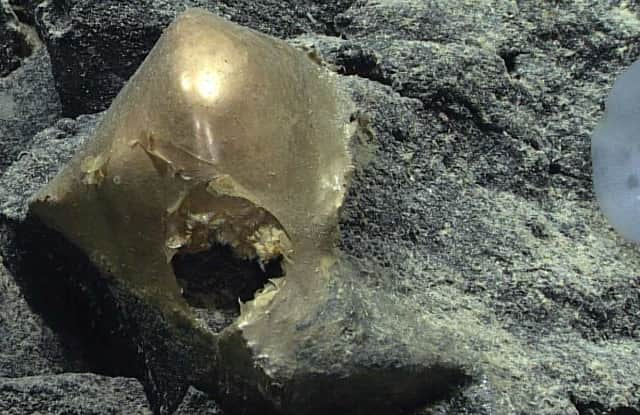Pacific Ocean: Mysterious 'skin-like' golden orb found on the ocean floor near the Alaska coast
and live on Freeview channel 276
A mysterious golden orb has been discovered on the ocean floor off the Pacific coast of Alaska.
The smooth object has a hole in the centre and was found at a depth of around two miles by a remote-controlled submarine explorer.
Advertisement
Hide AdAdvertisement
Hide AdScientists who found the orb, at the National Oceanic and Atmospheric Administration (Noaa) in the US suggest it could be a hatched egg or a marine sponge.


Currently, researchers are conducting tests and a DNA analysis to work out what the shiny object is. According to Noaa, the orb feels like “skin tissue”.
A remotely operated arm was deployed to “tickle” the egg, which was found to have a delicate “skin-like” texture. It was then gently “suctioned” up a tube for testing in a lab.
The dive is part of a mission to explore the Gulf of Alaska, known as the Seascape Alaska 5 expedition.
Advertisement
Hide AdAdvertisement
Hide AdIt aims to explore down to depths of four miles, including deep-sea coral and sponge habitats, and geological features such as mud volcanoes.
Over a live stream on 30 August, the scientists who found the skin-like orb offered theories about the identity of the object, including an egg casing or a sponge. They suggested that the hole was created by a creature hatching, or by a predator breaking in.
“I just hope when we poke it, something doesn’t decide to come out,” one scientist said. “It’s like the beginning of a horror movie.”
In images of the orb, the object has a golden appearance, but this was attributed to the reflection from the submarine’s headlights. A photo of the object taken in the lab suggests a brown-yellow colour.
Advertisement
Hide AdAdvertisement
Hide AdMany marine life, including deep-sea fish such as sharks, lay their egg cases on the sea floor. This makes them less likely to be washed away by ocean currents. Sponges are simple aquatic animals with dense, porous, skeletons that attach themselves to rocks.
Prof Kerry Howell, a deep-sea ecologist at the University of Plymouth, said that it is not unusual to find new species during exploratory missions, but that it would normally be possible to place them in a broad taxonomic category.
“We’ll often see new things but will usually have a pretty good knowledge of what they are. What’s unusual about this thing is we’re not even sure what it is. Is it an egg, is it a sponge, what is it?” she said.
“We’re going with egg because of the texture. It felt fleshy and it doesn’t have any obvious anatomy. It has a hole in it that suggests something has come in or gone out. But it doesn’t look like any egg I’ve ever seen,” she added.
Advertisement
Hide AdAdvertisement
Hide Ad“If it is an egg, the really interesting question is whose egg is it. It’s quite big. That’s not a small fish egg. That’s a sizeable thing.”
DNA tests should be able to establish which family of marine life the orb belongs to, although it is unlikely to identify a precise species since only a fraction of marine life has been sequenced.
The dive will continue until 15 September and can be watched via a live stream.
Comment Guidelines
National World encourages reader discussion on our stories. User feedback, insights and back-and-forth exchanges add a rich layer of context to reporting. Please review our Community Guidelines before commenting.
